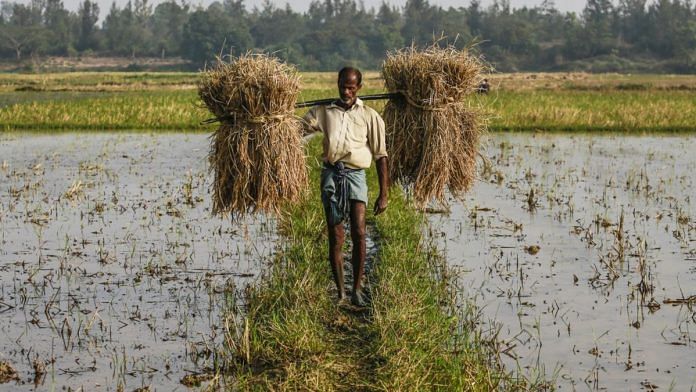New Delhi: The Bhupesh Baghel-led Chhattisgarh government Thursday launched the Rajiv Gandhi Kisan Nyay Yojana (RGKNY), which is meant to provide a minimum income to farmers through direct bank transfers.
The government hopes that this will aid farmers struggling amid the coronavirus outbreak and during the critical rabi and kharif crop seasons. There is also hope that the scheme will accelerate rural economic growth in the state and create jobs in the agriculture sector.
The scheme mirrors the Nyuntam Aay Yojana (NYAY) proposed by Congress leader Rahul Gandhi ahead of the 2019 Lok Sabha elections. NYAY had envisaged a monthly direct cash transfer of Rs 6,000 to the poorest five crore families in the country.
The launch of the scheme, which coincides with the death anniversary of Rajiv Gandhi, comes days after the Centre’s massive Covid-19 relief package, which has been criticised for focusing on loans rather than direct cash transfers.
ThePrint explains the contours of the Rajiv Gandhi Kisan Nyay Yojana.
Who will benefit from RGKNY and how?
According to Chief Minister Bhupesh Baghel, roughly Rs 5,700 crore will be transferred directly to bank accounts of 19 lakh farmers but the state government is looking to include tribals and other low socio-economic communities in due course of time.
Under its current format, however, a farmer whose crop has been procured by the government during the 2019-2020 kharif season is eligible for the payout of Rs 10,000 per acre in a year.
But farmers can be paid more than their landholdings.
That is because the government has set a metric of 15 quintals of crop yield per acre of farmland, to arrive at how much each farmer will be paid. In short, for every 15 quintals that the government procures from a farmer, it will pay that farmer Rs 10,000 a year.
So in effect, a farmer who sells 45 quintals of crop to the government will be deemed to have three acres, even if the farmer doesn’t own that much land, and will be paid Rs 30,000 a year.
The state, however, has made an exception for sugarcane farmers, who will be paid a one-time amount of Rs 13,000 an acre.
It rolled out the first instalment of Rs 1,500 crore Thursday that will benefit 9.54 lakh marginalised farmers, 5.60 lakh small farmers and 3.21 lakh large farmers.
The remaining Rs 4,200 crore will be paid in three other installments during the course of the year.
For now, the scheme covers only paddy, maize and sugarcane but the chief minister has said that will be extended to a number of other crops.
Are farmers who own less than an acre covered by the scheme?
Yes they are. As explained above, the payment will be based on procurement and will be proportionate.
For instance, a farmer who owns less than an acre but sells 7.5 quintals to the government will be eligible for a one-time payment of Rs 5,000 a year. This scale will be used for other farmers with even smaller landholdings.
Is this a first-of-a-kind DBT scheme?
Not really. While the scheme is ambitious in scale and complexity, the central government already has the Pradhan Mantri Kisan Samman Nidhi Yojana (PM-KISAN), launched in 2019, which provides Rs 6,000 per farmer annually in four instalments. There have, however, been reports of money not reaching the hands of farmers.
Other states too have had their own direct benefit transfer schemes. In January 2019, the Naveen Patnaik-led Odisha government came out with Krushak Assistance for Livelihood Income Augmentation (KALIA) aimed to provide Rs 20,000 annually per farmer. It was eventually merged with the PM KISAN scheme in December 2019 due to “financial constraints”.
The Andhra Pradesh government too runs a similar scheme. In October 2019, it came out with YSR Rythu Bharosa, which sought to provide Rs. 12,500 annually per farmer.
Why has the scheme landed in a controversy in Chhattisgarh?
The controversy stems from the promises that the Chattisgarh Congress had made ahead of the assembly elections in 2018. Back then, the Congress had promised to buy two paddy varieties — thick and slender — for Rs 2,500 a quintal. The MSP for the paddy varieties is Rs 1,815 and Rs 1,835 a quintal respectively. One quintal equals 100 kg.
During the 2019-2020 kharif season, however, the state government bought the paddy varieties at MSP — that is at Rs 1,815 and Rs 1,835.
The chief minister himself then constituted the special state-level committee to see how farmers could be paid the extra money. The committee’s report was placed at the state cabinet meeting on 13 May, in which the government announced its RGKNY scheme.
The opposition BJP is now alleging that the government is only paying the money it had promised the farmers and is couching it as a relief measure.
“The state government had promised a one-time payment of Rs 2,500 per quintal of paddy for farmers. This included the MSPs of Rs 1,815 and Rs 1,835 as set by the central government. It, however, only paid MSP costs and not the additional promised benefits,” former CM and senior BJP leader Raman Singh told ThePrint.
“Rather it continued buying time and even today, it is only paying one fourth of the promised amount. This not the ‘Kisan Nyay Yojana but Kisan Anyayay Yojana (not justice for the farmers scheme but injustice to the farmers).”
Also read: States’ consent not needed for Shramik trains now, Modi govt brings in order after disputes




So paying more money to large farmers is your idea of Nyay???
That’s always have been the case of Congress policy. Mostly landed farmer or middle class subsidies,